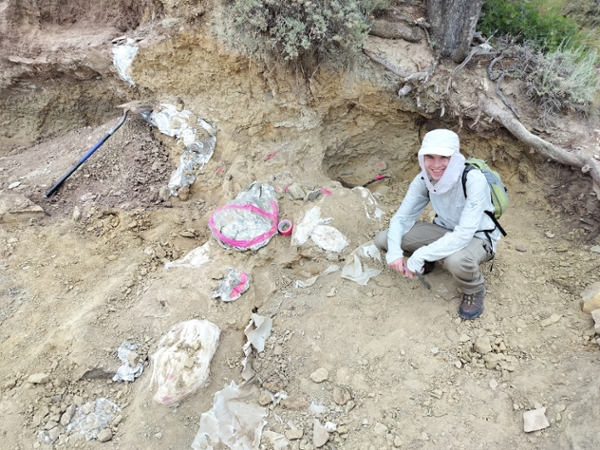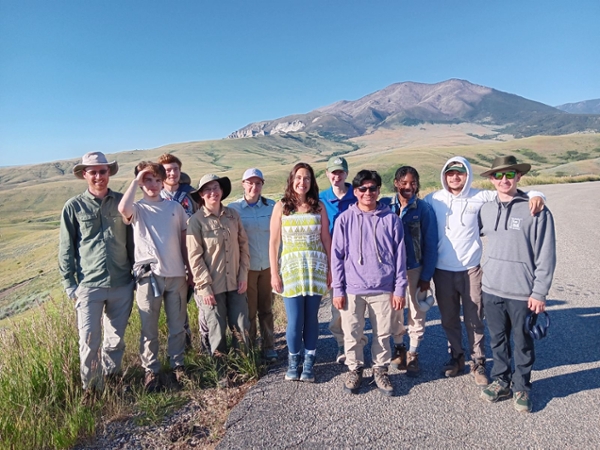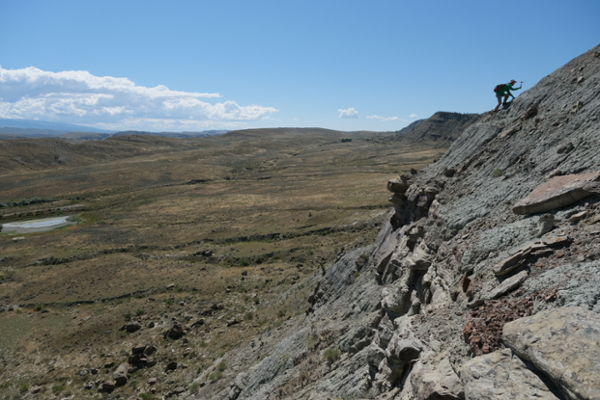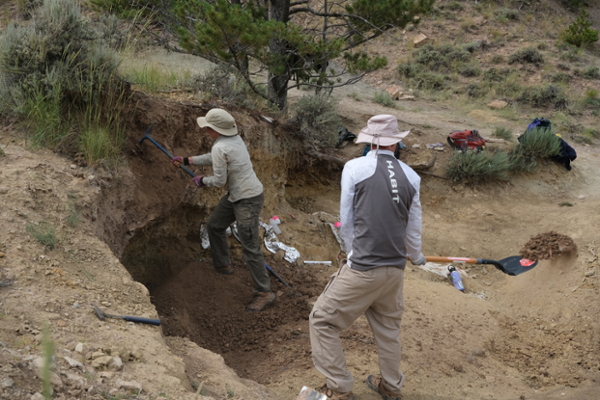Prof, students work on Virtual Field Trip about dinosaur research for high schoolers
Prof, students work on Virtual Field Trip about dinosaur research for high schoolers
Seemingly all students love dinosaurs.
Few, at least in high school, have access to the sciences needed to study them.
This summer, a Rowan University paleontologist and two students, working with students and faculty from Villanova University and the University of North Dakota, traveled to the western badlands of Montana to help create a Virtual Field Trip (VFT) so students everywhere can learn about the sciences involved in dinosaur research.
Kristyn Voegele, Ph.D., then an assistant professor of Geology in the School of Earth & Environment, said she and students Chris Rogoff and Peter “Trey” Shelton wanted to help make the VFT about hunting for dinosaurs because the creation of a free online tool speaks to a great need in K-12 education: a lack of resources in the geosciences.
The thrill of the work aside, Voegele said by spending a few weeks in the dinosaur boneyards she, her students, and her colleagues are helping to create educational materials that generations of high school students can use.
“The goal was to provide resources on the STEM disciplines, using paleontology and the study of dinosaurs as a hook for high school students,” said Voegele, who has since accepted a teaching and research position at the University of North Dakota.
The trip involved fieldwork in Montana’s Bighorn Basin just across the Wyoming border where researchers deployed professional search, discovery, excavation and removal techniques for a variety of dinosaur bones.
She said the three-year project will be available for free on the American Geosciences Institute’s website, most likely in the summer of 2026.
“We’re going back for two more years. Each year has a field season and the goal is to build out different parts of the VFT each year,” she said.
Rogoff, a senior Geology major with a focus on paleontology, said he couldn’t miss the opportunity to search for dinosaur fossils in an area known to be teeming with them.
“My dream is to be a paleontologist,” he said. “For paleontologists, a lot of the fun is being out in the field looking for fossils.”
He said large herds of sauropods, long-necked dinosaurs such as the Brontosaurus, traversed the region more than 100 million years ago and scientists have proof of these impressive herds from the field of bones they left behind. Many of those bones have been partially unearthed by erosion, Rogoff said.
“They basically all died due to a hypothesized drought long before the asteroid hit,” he said, referencing the calamitous strike 66 million years ago that killed off most of the dinosaurs and other life on Earth.
Shelton, a junior Geology major who’s also focusing on paleontology, said there are technical aspects of searching for, finding and excavating ancient bones that can only be learned in the field. The search area they worked in is owned by the Bureau of Land Management and can only be accessed with permits.
He said many of the fossils in the region were from marine animals, just as they are in Rowan’s Jean & Ric Edelman Fossil Park in Mantua Township.
“There were lots of belemnites, which were sort of like squid, and Devil’s Toenails, a bivalve like a clam or oyster,” Shelton said.
As for the VFT, Shelton expects it to have great potential to reach students, most of whom wouldn’t otherwise have a chance to search for fossils out west, at least not in high school.
“Science of this type enriches how you view the world,” he said, “and I think everyone deserves that.”
Photo credits: Shelton excavates in bonebed (Trey Shelton); Members of VFT crew out west; cliffside dig; fossil dig (Virginia Schutte)



